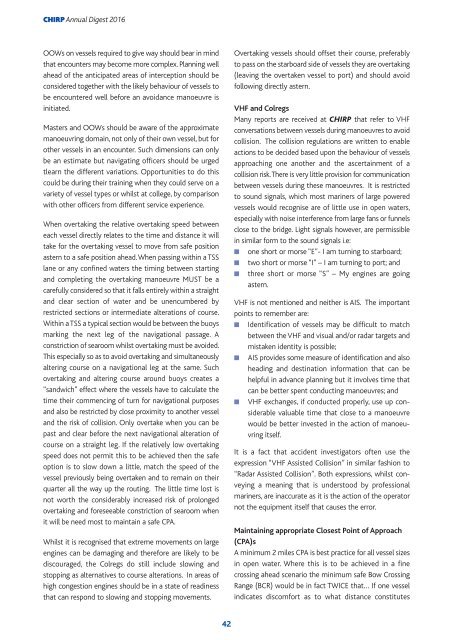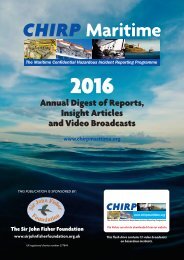CHIRP annual digest 2016 6th
Create successful ePaper yourself
Turn your PDF publications into a flip-book with our unique Google optimized e-Paper software.
<strong>CHIRP</strong> Annual Digest <strong>2016</strong><br />
OOWs on vessels required to give way should bear in mind<br />
that encounters may become more complex. Planning well<br />
ahead of the anticipated areas of interception should be<br />
considered together with the likely behaviour of vessels to<br />
be encountered well before an avoidance manoeuvre is<br />
initiated.<br />
Masters and OOWs should be aware of the approximate<br />
manoeuvring domain, not only of their own vessel, but for<br />
other vessels in an encounter. Such dimensions can only<br />
be an estimate but navigating officers should be urged<br />
tlearn the different variations. Opportunities to do this<br />
could be during their training when they could serve on a<br />
variety of vessel types or whilst at college, by comparison<br />
with other officers from different service experience.<br />
When overtaking the relative overtaking speed between<br />
each vessel directly relates to the time and distance it will<br />
take for the overtaking vessel to move from safe position<br />
astern to a safe position ahead. When passing within a TSS<br />
lane or any confined waters the timing between starting<br />
and completing the overtaking manoeuvre MUST be a<br />
carefully considered so that it falls entirely within a straight<br />
and clear section of water and be unencumbered by<br />
restricted sections or intermediate alterations of course.<br />
Within a TSS a typical section would be between the buoys<br />
marking the next leg of the navigational passage. A<br />
constriction of searoom whilst overtaking must be avoided.<br />
This especially so as to avoid overtaking and simultaneously<br />
altering course on a navigational leg at the same. Such<br />
overtaking and altering course around buoys creates a<br />
“sandwich” effect where the vessels have to calculate the<br />
time their commencing of turn for navigational purposes<br />
and also be restricted by close proximity to another vessel<br />
and the risk of collision. Only overtake when you can be<br />
past and clear before the next navigational alteration of<br />
course on a straight leg. If the relatively low overtaking<br />
speed does not permit this to be achieved then the safe<br />
option is to slow down a little, match the speed of the<br />
vessel previously being overtaken and to remain on their<br />
quarter all the way up the routing. The little time lost is<br />
not worth the considerably increased risk of prolonged<br />
overtaking and foreseeable constriction of searoom when<br />
it will be need most to maintain a safe CPA.<br />
Whilst it is recognised that extreme movements on large<br />
engines can be damaging and therefore are likely to be<br />
discouraged, the Colregs do still include slowing and<br />
stopping as alternatives to course alterations. In areas of<br />
high congestion engines should be in a state of readiness<br />
that can respond to slowing and stopping movements.<br />
Overtaking vessels should offset their course, preferably<br />
to pass on the starboard side of vessels they are overtaking<br />
(leaving the overtaken vessel to port) and should avoid<br />
following directly astern.<br />
VHF and Colregs<br />
Many reports are received at <strong>CHIRP</strong> that refer to VHF<br />
conversations between vessels during manoeuvres to avoid<br />
collision. The collision regulations are written to enable<br />
actions to be decided based upon the behaviour of vessels<br />
approaching one another and the ascertainment of a<br />
collision risk. There is very little provision for communication<br />
between vessels during these manoeu vres. It is restricted<br />
to sound signals, which most mariners of large powered<br />
vessels would recognise are of little use in open waters,<br />
especially with noise interference from large fans or funnels<br />
close to the bridge. Light signals however, are permissible<br />
in similar form to the sound signals i.e:<br />
■ one short or morse “E”- I am turning to starboard;<br />
■ two short or morse “I” – I am turning to port; and<br />
■ three short or morse “S” – My engines are going<br />
astern.<br />
VHF is not mentioned and neither is AIS. The important<br />
points to remember are:<br />
■ Identification of vessels may be difficult to match<br />
between the VHF and visual and/or radar targets and<br />
mistaken identity is possible;<br />
■ AIS provides some measure of identification and also<br />
heading and destination information that can be<br />
helpful in advance planning but it involves time that<br />
can be better spent conducting manoeuvres; and<br />
■ VHF exchanges, if conducted properly, use up con -<br />
siderable valuable time that close to a manoeuvre<br />
would be better invested in the action of manoeu -<br />
vring itself.<br />
It is a fact that accident investigators often use the<br />
expression “VHF Assisted Collision” in similar fashion to<br />
“Radar Assisted Collision”. Both expressions, whilst con -<br />
veying a meaning that is understood by professional<br />
mariners, are inaccurate as it is the action of the operator<br />
not the equipment itself that causes the error.<br />
Maintaining appropriate Closest Point of Approach<br />
(CPA)s<br />
A minimum 2 miles CPA is best practice for all vessel sizes<br />
in open water. Where this is to be achieved in a fine<br />
crossing ahead scenario the minimum safe Bow Crossing<br />
Range (BCR) would be in fact TWICE that… If one vessel<br />
indicates discomfort as to what distance constitutes<br />
42



